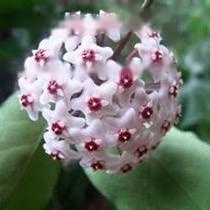
Chinese name: Qiulan
Latin name: Hoya carnosa (L. f.) R. Br.
Aliases: Ma Liujie, dog tongue vine , iron feet, etc.
Distribution area: distributed in Yunnan, Guangxi, Guangdong, Taiwan; other tropical and subtropical regions are also cultivated or wild.
Subjects: Rhododendron genus
1. Morphological characteristics of Cymbidium
The genus Cymbidium is a genus of Rhododendron genus. Climbing shrubs, epiphytes on trees or rocks, with angry roots on stem nodes. The leaves are opposite, fleshy, oval to oval-oblong, obtuse at the top, rounded at the base; lateral veins are not obvious, about 4 pairs. Cymes umbel shape, axillary, with about 30 flowers; flowers white, 2 cm in diameter; corolla radial, short corolla tube, lobes glabrous on the outside, many papillae on the inner surface; accessory corolla star-shaped, outer angle acute, middle The ridge is raised, the edge is folded into a pore, the inner corner is sharp and upright; the pollen block is 1 per cell, elongated, and the side is transparent.
2. Growth Habits of Orchid Orchid
Orchid Orchid is epiphytic on tree trunks and stone walls. In summer and autumn, it is necessary to maintain a high air temperature, and avoid exposure to the hot sun. If the sun is too strong, the leaves will turn yellow, the color will be rough and dull, and the suitable temperature is 20~25'C. Except for the warm areas in southern China, potted plants It needs to overwinter in a greenhouse, and the temperature in winter is not lower than 1 °C. It can bloom in 3~4 hours of sufficient sunlight every day. In areas with insufficient light, it is often potted and foliaged; it grows vigorously in soil rich in humus and well-drained, which is more suitable for more light. and slightly dry soil.
3. Planting method of Orchid spp.
Planting of Orchid spp. in hanging pots is 15 to 20 cm, and 3 to 5 seedlings are planted in each pot. A mixed substrate of leaf mulch, garden soil and coarse sand is used for potting, and a small amount of bone meal is added. During the growth period, the temperature above 20°C and high air humidity are required, and there is sufficient sunlight for 3 to 5 hours a day, which is conducive to the growth and flowering of succulent leaves. Water adequately, keep the basin soil moist, and avoid using calcareous water. But the temperature is too high, the fertilizer and water are too much, the vine stems grow slender, the leaves become thinner, and the color spots are not obvious. May to August is the growth period, and fertilizer is applied every half month. It is better to apply more potassium fertilizer, spray water twice a week in summer, and avoid spraying on the inflorescence. After the inflorescence appears, do not move it. The potting soil should be kept slightly moist during the winter dormancy period.
Guess you like it
Hyacinth | Other side flower | Lily | Peach blossom | Plum blossom | Orchid | Chrysanthemum | Clivia | Lotus |
Pueraria | Peony | Eustoma | Frangipani | Calendula | Purple Magnolia | | Smiley Flowers | June Snow| Cineraria | Cannonball Flower | Desert Rose |
![[Dog Training 5] The training method of pet dog dining etiquette](/static/img/12192/12192_1.jpg)




